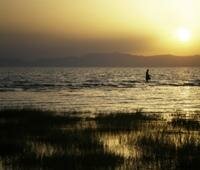Water Conflict: Violence Erupts Along Ethiopia-Kenya Water-stressed Border
Issue:Competition over resources
In a small village along the waters of Lake Turkana in northwestern Kenya, two fishermen were murdered last month as they were putting out their nets.
A cascade of retaliatory violence between the Kenyan Turkana and Ethiopian Daasanach (sometimes called Merille) has led to the deaths of at least four Ethiopians and 20 Kenyans ethnic groups, though some Kenyan government officials place the toll as high as 69, according to the Kenya-based Daily Nation. Though the fighting has been localized, it has put pressure on both nations to deal with strife between nomadic groups who are competing for diminishing resources.
Both groups are traditionally pastoral nomads living within the Elemi Triangle—a once disputed area between Kenya, Sudan, and Ethiopia—which has dry pastureland, historically used by both the Turkana and the Daasanach, as well as the Didinga, Toposa, and Inyangatom (also called the Dong’iro) communities.
The Turkana live in northwestern Kenya, making up 2.5 percent of the national population, or close to a million people, according to the 2009 Kenyan census. The Daasanach primarily reside in southern Ethiopia and make up less than 1 percent of the national population, or around 50,000. More recently, the Daasanach have lost significant portions of their lands and animals—in part due to climate change—and have become more agropastoral in nature.
Citing Joseph Nanok, Kenya’s forestry assistant minister, the Daily Nation reported that the traditional border between the Turkana and Daasanach people was located at the Omo River Delta, which flows into Kenya’s Lake Turkana from Ethiopia. This border, however, has been moving south due to receding waters.
According to The Christian Science Monitor, the Daasanach have begun increasingly cultivating the land and fishing the waters of the River Omo-Lake Turkana Delta, where they compete with the Kenyan Turkana people for both land and water resources.
Thus, not surprisingly, the recent attacks coincide with the settlement of an estimated 900 armed militia and 2,500 Ethiopian civilians on Kenyan territory around Lake Turkana. The Kenyan government has made claims that these illegal immigrants have taken control of 10 Kenyan villages and has vowed to send them back to Ethiopia, according to the Daily Nation.
Though this appears to be a territorial dispute, it can be, at least partially, attributed to the sharing of stressed water resources.
“Water exacerbates current tensions,” Aaron Wolf—a leading researcher on global water conflict and resolution and a professor at Oregon State University—told Circle of Blue. “It is very hard to separate a water conflict from a land conflict from an economic conflict, because water is tied to everything we do.”
Wolf’s research team conducted a five-year study about the causes of water conflicts and concluded that there are two major factors that play a role:
- The rate of change within a water basin. Scarcity, economic growth, and population growth can all affect the availability of water resources.
- The institutional capacity of the region; what Wolf calls “the human systems built to mitigate the change.”
It is also important to define a conflict, since people’s interests frequently conflict, while violence is much more rare, Wolf added.
“If someone builds a dam and negotiates with all of the people affected, there probably won’t be a conflict,” Wolf said. “Conflict occurs if there is sudden, rapid change [to the water resource] and an absence of institutional capacity…As you drop in scale, the likelihood of violence increases. Whereas two countries will rarely go to war over water, you see tribal violence quite often, or two farmers who will shoot at each other.”
However, Wolf stressed that, although water can be a source for tension, it can also be the catalyst for creative, peaceful solutions.
“Water brings focus on settings that are stressful, but that same focus is used to create treaties and negotiations—even between people who don’t like each other very much,” he said. “There is a rich history of stakeholders coming together. When countries do anything about water, cooperation outnumbers conflict two to one.”
For more information on water conflicts across the globe, see the Pacific Institute’s Water Conflict Chronology database.
Image source: Aocrane
Article source: Circle of Blue
 Delicious
Delicious Digg
Digg StumbleUpon
StumbleUpon Reddit
Reddit
Posted on 1/07/11

Comments
Post new comment